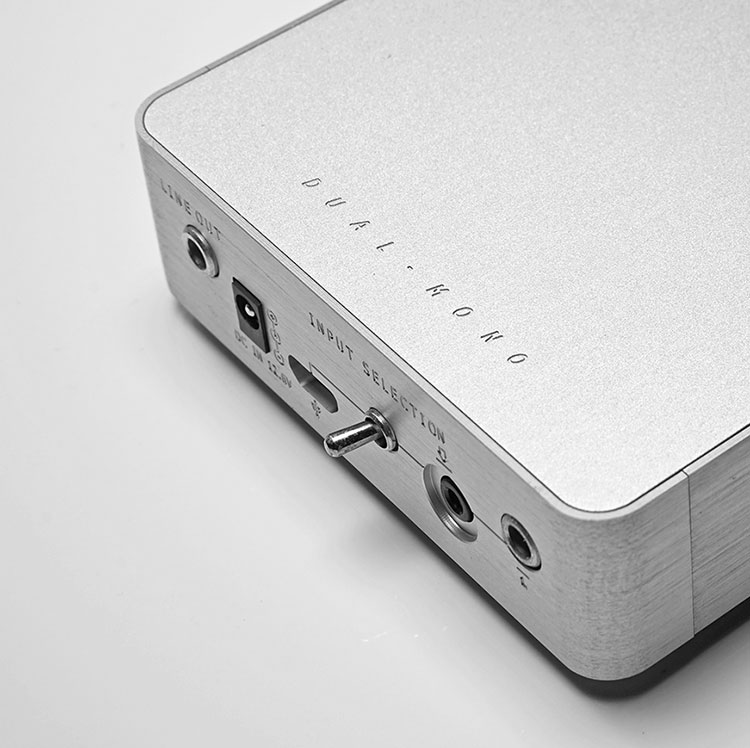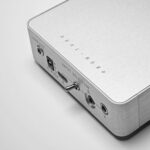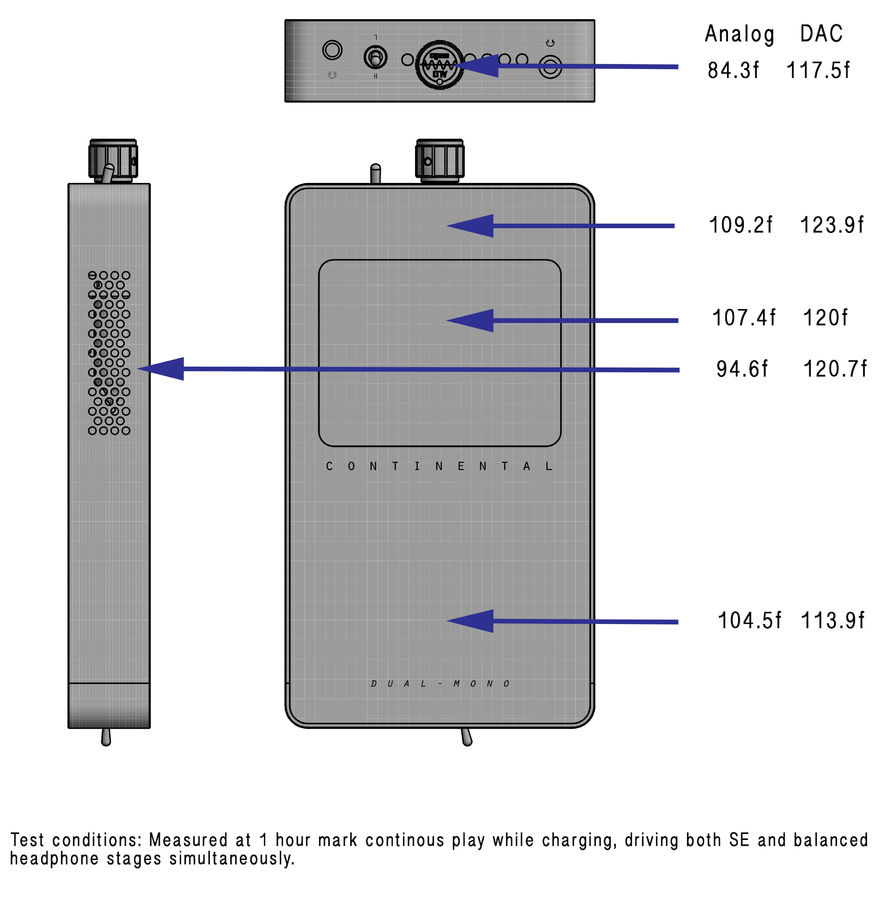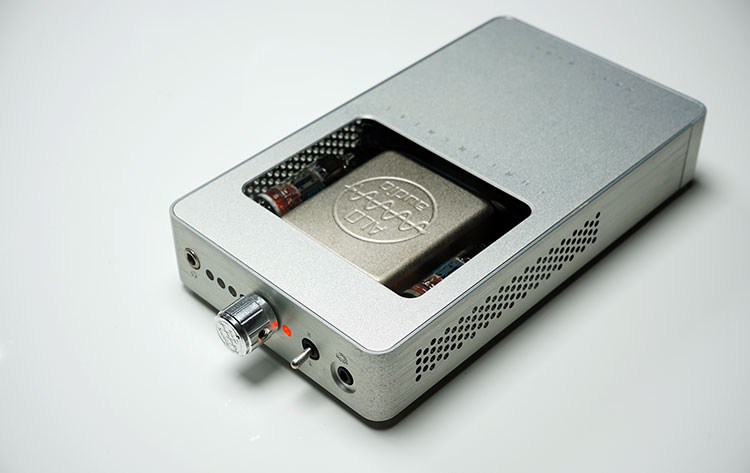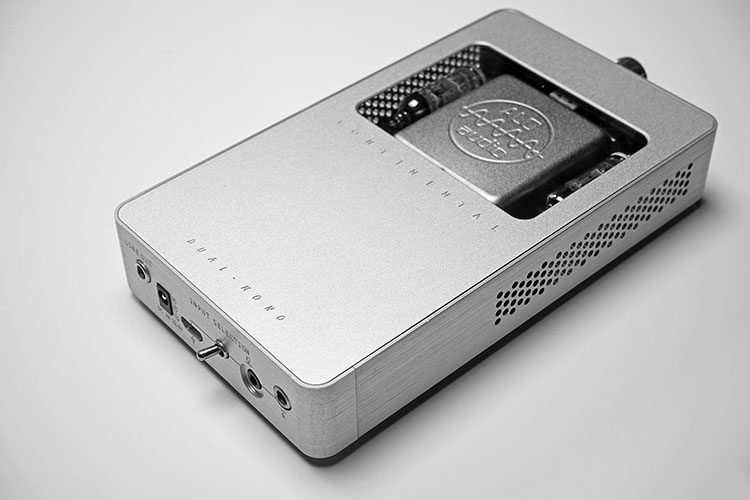The ALO Audio Continental Dual Mono is a unique portable dual-New-Old Stock 6111 Vacuum Tube amplifier and Wolfson-powered DAC. It is priced at $1495.
Disclaimer: This is a sample sent in exchange for our honest opinion. Headfonics is an independent website with no affiliate links or status. We thank ALO Audio for this opportunity.
To learn more about ALO Audio products on Headfonics you can click here.
Note that this article follows our latest scoring guidelines, which you can read up on here.
The Studio 6 by ALO Audio is their most expensive product for sale to date. A behemoth of a tube amp that we got and will review with Aplomb in the coming weeks. However, the Continental Dual Mono DAC/AMP (CDM) released a few months back is quite probably the company’s most important product release in a long time.
If you played with the Pan Am a few years back, you might get what ALO was after with the CDM but this is on a whole new level.
The Continental Dual Mono is not just a revision of the very popular analog tube portable amp from a few years back but also a very significant re-engineering of every aspect of the Continental’s internals and externals.
Combined with the ethos and spirit of the Pan Am & The Studio 6 this is something that I believe is very special and worthy for the price of $1495.
Tubes
Now price is always debatable and certainly, the Continental Dual MonoCDM is no exception to that wider debate of value for money. When I first received it I was wondering if the CDM might be too niche for people to buy into it also.
After all, you have a few stiff competitors already in the price bracket with the Aurender Flow slightly lower in price and the Chord Hugo slightly higher in price and both offering similar features and higher resolution rates.
But the magic of tubes is hard to ignore and the choice of DAC chip is a real eye-opener in the days of radically advanced highly resolving chipset implementations. Here is a DAC/AMP built for pure sound and not just for what you can do with it.
Remember how we used to buy things for how they sound in audio and not just how they look or what features they had? The Continental Dual Mono is just that sort of audio device. It is not just any old sound either, but a rich tonally pleasing sound that will make old-school analog fans positively purr.
What You Get
The humbler 2015 version of the RX analog amp should give you a bit of a hint at how ALO is pitching these days. There is less of the 1950s aura to the packaging though the Continental name stays right there. In fact, the outer packaging is rather austere in many ways with its plain brown cardboard packaging, quite the throwback.
However, inside it’s really all ALO, and if you were buying that RX you would know that it came with a big expensive Green Line USB cable. This same cable is right there in the brown box along with the CDM itself, a few straps (3), and a wall charger (110v – 240v).
Design
Oh goodness, the Continental Dual Mono is one beautifully machined DAC/AMP with design cues from the Studio 6 and RX but on a whole other level than its portable analog sibling. This is a classy retro-styled transportable class unit with the Studio 6 style venting on the right and left panels and functionality to the front and rear.
There is nothing slapdash about the construction from the engraved signage to the Gorilla Glass enclosure showing off the ALO Audio logo on a central heat protector plate and the tubes on either side. Turn the amp on and watch those babies light up – that’s the magic of tubes on a visual level and it never ceases to get head-turning at any meeting.
That Casing
The casing itself is designed from CNC’ed aluminum and if you happen to watch Ken Ball’s disassembly video of the CDM you will see that the casing is split into 4 parts; a backplate, a bottom, and a top plate, and the front sides are all one piece that slides easily in and out.
It might seem complicated looking but it is actually one of the better-designed enclosures and certainly something the DIY guy or tube roller will get stuck into with relish.
The casing also acts as one big heat sink to help dissipate the heat from the hybrid tube setup so on the one hand you do have the vents to help the tubes breathe but on the other hand, the casing helps manage and disperse the heat generated on the inside.
Disco Inferno
The knock-on effect is that the Continental Dual Mono does get a little hot to the touch especially when you start using the DAC functionality. For tube lovers, this is nothing new but I would advise those coming to this for the first time to handle it with a little bit of caution.
During DAC and amp use keep the immediate area around the vents free of blockages so the unit can breathe easy and for the love of all things hold do not put your chocolates on top – a fondue CDM is not a pretty sight.
For reference, ALO Audio provided this really nice little temperature diagram on Head-fi a few months back that shows how their typical tests produce these heat measurements on various parts of the casing with an ambient room temp of 76f.
Operating Temperature
The typical operating temperature of the Continental Dual Mono in analog use can range from 84.3f on the volume pot to 109.2f on the plate part immediately between the pot and the Gorilla Glass. When the DAC is in use the CDM volume pot rises to around 117.5f to 123.9f in the same areas. Everywhere else is somewhere in between.
Again, for tube users, this will present nothing new to the equation, we long understand heat as an integral part of any tube amp design. Those used to units such as the Flow and the Hugo which are solid-state though may be hit with a surprise.
Personally, I think this puts the Continental more transportable than the portable class as sticking something like this in your pocket is both diametrically unmanageable and thermally questionable. As such the CDM sits proudly on a desk during usage be it at a cafe, office, or at home.
To the Front
The Continental Dual Mono front panel is all about the headphones with both a single entry 3.5mm jack output to the far left and a 2.5mm balanced TRSS output to the far right.
In-between you have the same machined aluminum materials for a gain switch (low and high), the usual and always well-made ALO Audio volume potentiometer knob right in the middle, and slightly to either side of the knowledge you have an array of LED lights.
The one on the immediate right is the ‘power on’ indicator in matching orange to the stock tubes glow and the group of 4 to the left indicates the sample rate the CDM DAC component is currently decoding at.
- Red = 44.1 / 48kHz,
- Green = 88.2 / 96kHz,
- Blue = 176.4 / 192kHz,
- White = DSD64
To the Rear
The back is all about the signal outputs and inputs be it digital in the case of the micro USB port in the middle, or analog with a 2mV line out to the left as you look at it. The Continental Dual Mono also features a 2.5m balanced input to the near right and a stereo line input to the far right.
Nestled in between the USB and the balanced line out is a little toggle switch built in the same form as the front gain switch to allow you to change your input selection from digital to analog balanced depending on your preference.
Curiously the 16.5v/1.5 A charger connection is nestled in between the USB and line-out jack ports. This is a rather challenging position to have the power if you fancy a bit of playback on the mains.
No worries if you have some slimline 3.5mm jacks but if like me, you have something a bit thicker say a 3.5mm to dual RCA and you are running it as part of a system out via its DAC feature to an amp then you simply can’t fit the AC plugin at the same time, there is not enough room.
Now that’s a question for my cables rather than a design flaw, but it does mean thick reinforced jacks and USB cables and charging won’t all work at the same time due to space considerations. If you have slim jacks, then you are good to go.
The only other nod to modernity in this interface that is missing is any form of SPDIF input but in reality, I found during listening sessions I never really missed it but it is something to be aware of if you are looking for a DAC with a SPDIF interface.
Internal Hardware
DAC
This is probably the one area people will be divided on but I think it is a very smart choice indeed by ALO. I am a fan of Wolfson chips when done right. The WM8740 and WM8741 always seem to be implemented with a really nice organic and natural sound and when combined with tube amps they really are very smooth and rich.
The Sabre ESS chips might be technically superior and for many, a flagship DAC manufacturer the ESS Sabre32 32-bit DAC chips have been at the heart of the drive for supreme clarity, detail retrieval, and analytical win.
But a badly implemented ESS chip can suffer from glare, a harsh treble, and a thin sound. That’s not for everyone and I have heard that glare more than a few times.
Limitations
The downside to using a Wolfson WM8741 is the limitation in sample rates versus the more modern PCM and ESS chips. It will not do DSD128 and DSD256 in the Continental Dual Mono so sadly out goes my Pink Floyd collection in that format.
It will, however, decode at DSD64 which might be as far as some people will go money-wise on high-definition tracks. As such the Continental Dual Mono resolution rates are not class-leading for a DAC and it won’t be the pinnacle of clarity.
Those also looking for a razor-flat, transparent, and very neutral signature will also probably prefer to go with the ESS DAC-equipped units such as the Aurender Flow and the ES9018K2M.
The upside to the WM8741 for me is that just sounds so much more natural or organic sounding than the ESS in most implementations that I have heard to date, even if it will come second-best overall in the micro detail and treble articulation.
The greater majority will also find the WM8741 to be just that bit more musical in most well-engineered setups, particularly with tubes. I have only heard one average WM8741 in years from a DAC unit I will not name that suffered from a lack of dynamics compared to cheaper dual WM8740 implementations a few years back.
Apart from that, I give it two thumbs up. For me, the Wolfson chips have the potential to make ESS chips sound positively boring in all but the best DACs out there.
Hybrid Amplification
The Continental Dual Mono is not a pure tube amp/DAC but instead, it’s a hybrid tube/SS designed to maximize the strengths of both characteristic signatures into one sound.
The Continental Dual Monocan accommodates miniature single-triode and dual-triode tube designs. ALO Audio here decided to use as stock 2 NOS 6111 Vacuum Tubes (Sylvania 6111WA) with low microphonic implementations that are rollable to give the sound signature that rich midrange appeal we love about tubes.
At the same time, it keeps a hold on the detail, clarity, and bass tightness that is a key feature of solid-state designs. That tube buffer functionality combined with the CDM DAC makes the pairing of the two seem like pure bed buddies. They go together quite well indeed.
I did mention the Continental Dual Mono tubes are rollable a few times and with the 6111 series, you have a ton of options from Raytheon, Mullard, RCA, Jan Philips, and Sylvania to name but a few brands out there, each bringing their unique or subtle sound to the table.
Most matching pairs can be bought from reputable stores for around $10-30 depending on what you select. I am a big fan of Mullards and the rich sound they can produce having had variations of these back in the Little Dots about 6 years ago.
Output
A fully balanced DAC is no good without a reciprocal balanced amp and that is just what you have with the amp stage inside the Continental Dual Mono. The dedicated linear voltage design of the amp inside the CDM is implemented at each stage to reduce crosstalk and output noise, and generally produce a very clean power supply right across the board.
This combined with a focused tube design low on microphonic “pings” and a natural-sounding DAC implementation yields an amping output that works very well indeed with both IEMs on low gain and higher-powered planars.
It is a versatile amping stage that offers both balanced and single-ended output and a very good line out indeed. A line out that pairs very well with its bigger sibling, the Studio 6.
Vinnie Rossi Partnership
Much of the work put into this power design can be attributed to both Ken Ball at ALO and co-designer, Vinnie Rossi. For those sporting AK DAPs, you will know him very well indeed from his work at Red Wine Audio and the RAW-modded DAPs designed to kill that 22ohm monstrosity called the AK100 MK1.
He is also responsible for a very respectable line of amps under the Lio brand. Vinnie is recognized for his groundbreaking work under the Lio line on power supply designs.
On the Continental Dual Mono, he is at it again with a power supply design that does away with step-up transformers or DC-DC converters typical of tube setups, and in comes power directly fed from the battery itself.
Battery
ALO has decided to use a 3-cell Panasonic NCR18650 pack to power the amplification stage of the Continental Dual Mono. These are very highly rated battery cells that output up to 11.1v when lined up right into the amplification and the tube stage.
This combined with the linear voltage-regulated design yields that nice low noise floor for IEMs with more than capable dynamics for higher-end cans. It’s also a replaceable battery pack with a pop-out cable and can be bought for around $10 per cell.
The battery life is quite respectable actually for a device this size running at around 5-7 hours depending on the use of the DAC or amp only. Portable yes, transportable is much better as you can indeed plug the AC during usage to keep things ticking along without the battery draining.
Functionality
The Continental Dual Mono can function as both a DAC and an amp-only unit or as both depending on your needs. No, it does not have that SPDIF but it does have a fully balanced DAC/AMP output so it can handle 2.5mm TRSS inputs.
As a pure DAC, you can connect directly to your PC or MAC and line it out to any amp with an RCA input be it single or dual. If you are running a Windows setup you will need C-Media 2.0 drivers which are listed as links at the end of this review. Mac users as always do not need drivers except for DSD, it’s plug-and-play (hate you!).
Truth be told I had some teething difficulties setting it up initially for DSD playback on both Foobar and JRiver Media Center but I was running off some slight misinformation and after a bit of tweaking things worked out just fine. If you are a first-time user of DSD I have included the ALO Audio setup guide in the links section at the end of this review.
But there is more, oh yes the Continental Dual Mono is OTG capable with Android and in most cases with iOS 9.02 using the camera connector kit.
Now whether or not you can tolerate a strapped phone on the top or below the CDM in full heat dripping DAC mode I am not sure but it’s there at least in desktop mode and an attractive option I must say for casual listening on the high end.




